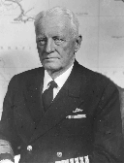|
 On December 25, 1941, the four engine Coronado Patrol Bomber (PB2Y) banked over Pearl Harbor and slowly and gracefully descended toward the water’s surface. It had been a long, bumpy trip, one resembling a ride in an old car on a rut-strewn country road. Admiral Chester W. Nimitz viewed the massive destruction from the Plexiglas bubble on the plane’s side. Rain pelted the aircraft’s windows as it headed for its landing area. It was a disheartening, discouraging sight. Black fuel oil covered East Loch in the main anchorage. The battleship, Oklahoma, and the target ship, Utah, were bottoms-up in the black water. A minelayer rested on its side. In the distance the heavily damaged battleship, Nevada, was aground in the shallows. The California, West Virginia, and Arizona lay sunken. The only objects visible were their topsides, their blackened, twisted masts showing above the water’s surface. At 7:00 a.m., the PBY landed in the choppy water and eased to a stop. The door flew open. As soon as it opened, the smell of black oil, charred wood, blistered paint, and burned, rotting bodies attacked Nimitz’s senses. On December 25, 1941, the four engine Coronado Patrol Bomber (PB2Y) banked over Pearl Harbor and slowly and gracefully descended toward the water’s surface. It had been a long, bumpy trip, one resembling a ride in an old car on a rut-strewn country road. Admiral Chester W. Nimitz viewed the massive destruction from the Plexiglas bubble on the plane’s side. Rain pelted the aircraft’s windows as it headed for its landing area. It was a disheartening, discouraging sight. Black fuel oil covered East Loch in the main anchorage. The battleship, Oklahoma, and the target ship, Utah, were bottoms-up in the black water. A minelayer rested on its side. In the distance the heavily damaged battleship, Nevada, was aground in the shallows. The California, West Virginia, and Arizona lay sunken. The only objects visible were their topsides, their blackened, twisted masts showing above the water’s surface. At 7:00 a.m., the PBY landed in the choppy water and eased to a stop. The door flew open. As soon as it opened, the smell of black oil, charred wood, blistered paint, and burned, rotting bodies attacked Nimitz’s senses.
When Nimitz stepped from that plane, he started a fateful journey into history. In just a few days, he took command of the entire American Pacific Fleet as its Commander in Chief or CINCPAC. Nimitz had turned down one of most coveted promotions in the United States Navy in January 1941 because Nimitz felt a more senior officer than he should get that prized assignment. But when the Pearl Harbor debacle happened and Secretary of the Navy Frank Knox offered the command a second time, he knew he must accept the assignment because his country was now at war. 
After supervising the dramatic recovery of all the battleships at Pearl Harbor except for the Oklahoma, Arizona, and Utah, he set upon the formidable task of prosecuting the war against the Japanese. After mastering the defeat of the Japanese at Midway in June 1942, he commanded the American Navy’s string of victories as it progressed across the vast Pacific Ocean toward those fateful days in October 1944 when, under joint command with the charismatic, bombastic, and imperious General Douglas MacArthur, the vast American armada of over 500 ships of all types approached the Philippine Islands and toward the precedent-setting Battle of Leyte Gulf. 
|
